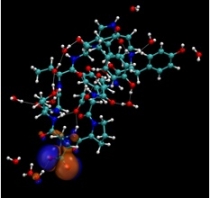CHEM 2552: Named Reaction

Welcome! You'll need a College of DuPage Library card in order to use most of the resources below from off campus.
Questions about anything on this page? Feel free to use my contact info to the right, stop by the Reference Desk, or contact us by email or chat.
- Find Your Reaction
- History
- Methodology and Results
- Articles
- Future Studies/Experimental
- Spectra
- Cite
Before We Get Started
Looking for a general book that explains how to conduct chemistry research? Check out Chemical Information for Chemists: A Primer. We have two copies, one in reference, and one in general, and the book covers patent searching, physical data, reaction searching, and many other topics of interest for chemistry research.
You will also want to create a SciFinder Account in order to do much of your research for this project. Follow the directions on the linked page to get started, and contact me if you have any questions about setting up an account or searching.
Find Your Reaction
You can use the sources here to find a reaction of interest, get general information about the reaction, and answer questions about the reaction and its mechanism. Struggling to find a reaction to write about? Try the following steps:
Use a Library Book
We have several organic chemistry textbooks on reserve and in the general collection. Skim through the index to see named reactions listed. Browse the general collection around QD 251.2 and QD 261 or search the catalog. You can also search for "name reaction" OR "named reaction" in the catalog.
Need help finding a textbook?
Click on the Catalog link at the top of this screen, and
1) type in "organic chemistry textbook."
2) Select "Books & e-books."
3) Select "COD Library Only."
Use Google
Choose a molecule of interest and see if there is a named reaction that makes it. Search in Google: name of molecule and reaction to synthesize or reaction to produce. Be sure that your molecule is the product of a reaction and that it is a NAMED reaction.
Name-Reaction.com
While Name-Reaction.com doesn't have most of the info you'll need for your report, it does have a long list of named reactions and short info about them that is easily browseable.
Finding Historical Information:
Macmillan Encyclopedia of Chemistry: Reference QD 4 .M33 1997. 4 vols.
Check this encyclopedia for articles on many named reactions. You'll find basic descriptions and illustration of reaction mechanism to description, illustration, history, substrate, and reaction conditions.
Top Drugs: Their History, Pharmacology, Syntheses: On Reserve: RS420 .L535 2015
This book shares the chemistry behind 10 prominent drugs, including the product history, the mechanism of action, structure-activity relationship (SAR), bioavailability, metabolism, toxicology, the discovery route, and the process route.
Contemporary Drug Synthesis: On Reserve: RS403 .C667 2004.
Slightly older book, but still helpful: use the index to ID where your reaction is named in the synthesis of a drug. Great resource for identifying a product. Includes structure of drug, use of the drug, illustration of the synthesis of a drug. Make sure to check the list of references for potential additional sources.
Strategic Applications of Named Reactions in Organic Synthesis by Laszlo Kurti and Barbara Czako on Reserve: QD262 .K86 2005
This book provides a lot of helpful information, including a description, a description/illustration of a mechanism, utility (examples of drugs/chemicals produced, including descriptions and illustrations), and a list of references organized by type.
Name Reactions. 5th ed. by Jie Jack Li. Reference: QD291 .L5 2014 and (4th Ed. Online)
Mechanisms of the reaction are illustrated, examples of the reaction using specific reagents and conditions. Includes original publication identifying the reaction (written by scientist who discovered it.)
Credo will also often give you information about the background of an experiment (though not in as much detail.)
History
Dictionary of Scientific Biography 18 vols. Reference Q 141 .D5
This is your best bet for historical information on your scientist. Use index in volume 16 to find biographical information on the person the reaction is named for. Review bibliography for additional sources.
Cambridge Dictionary of Scientists Online.
Great Chemists Reference QD 21 .F35
The Biographical Dictionary of Scientists: Chemists Reference QD 21 .B48
Methodology and Results: Including Safety, Health, and Environmental Effects
Use any of the following resources, both online and in print, to discover xxperimental, health and environmental data for your reaction product.
March's Advanced Organic Chemistry On Reserve: QD251.2 .M37 2013
Provides a description/illustration of a mechanism with detailed description of various reaction conditions, and also criteria for and examples of good reagents.
Hazardous Chemicals Desk Reference. Reference T 55.3 .H3 L49
Start at the introduction to make sense of the entries. Safety info here as well.
NIOSH Pocket Guide to Chemical Hazards. Online and in Reference T 55.3 .H3 N56
Chemical/physical properties, with personal protection and other safety info listed.
Sax's Dangerous Properties of Industrial Materials. 5 vols. Reference T 55.3 .H3 539 2012 and Online
Entries are organized alphabetically by DPIM Entry code. Use the index in volume 1 to locate your molecule. Check the introduction (p. xi) to make sense of your entry.
Comprehensive Toxicology Online.
Provides explanation of the effects of chemical and physical agents on biological systems.
Micromedex. Includes links to Physicians Desk Reference, USP DI and many other drug sources as well as toxicology and other health effects and sometimes MSDS
HAZMAT Zone Use this database to look up safety information on MSDS Data Sheets. Only one user at a time may access this database. User Name: codlib Password: library
Still not finding what you need? Try Google. It can be useful to put quotation marks around phrases: "Cannizzaro Reaction," "benzoic acid". Add more specific terms: nmr, uv, history, safety...
If you want laboratory information from university chemistry departments, add this string: site:.edu Often, there are laboratory procedures for synthesis or background information on a reaction or molecule.
Chemical Literature
Use the databases to shore up any gaps in your research so far. See examples below.
Scifinder will allow you to search by the name of your reaction or the product. Do a "research topic" search and then limit your results by date. Remember that citation information is located to the right of the screen in SciFinder.
Medline Lists research articles from chemical, medical and environmental journals. Most specific search is Advanced search: use CAS registry number and change format from Keyword to Chemical Substance.
Science Direct Search reaction name or chemical synthesized. be sure to choose "Subscribed journals" in center of page. Almost all titles retrieved will be fulltext.
Academic Search Complete Use advanced search to link terms (named reaction and molecule synthesized or name of product and environment*...) Choose Scholarly publications. Not everything will result in fulltext but several ACS publications are indexed. Go to local college libraries or order articles on interlibrary loan.
Interlibrary Loan
Not finding the article you want in full-text online? Start by checking our journal locator to be sure that the article isn't just in another of our databases. Type in the journal name to see if we have access to the journal, and if so, for which dates.
For journal articles, bibliographic citations in the chemical literature tend to give abbreviated titles. Talk to Laura if you need help finding the full journal title when requesting an article. Guide to chemistry journal abbreviations from University of British Columbia will be helpful.
Still not finding your article?
Use Interlibrary Loan to get books and articles from other libraries. For books, be sure to get author, title and date whenever possible.
Chemical citations often do not give the title of the article or full range of pages, so you will need to fill in a topic: use parentheses: (About name of molecule) and starting page number with a + after it.
Interlibrary loan of books can take 10 business days and articles may take 5 business days, so give yourself time to get these materials.
Future Studies/Experimental
In addition to the information found in the articles you look at, Google Patent Search and PubMed can be good places to look for information.
PubMed
PubMed indexes many ACS journals as well, and searching for your reaction in quotes "Hunsdiecker reaction" will pull up some of the most current articles published on the topic.
Google Advanced Search for Patents
Use Google Advanced Search for Patents to search for a named reaction of interest to see how it has been used in a patented chemical process (aka significance.) You can also search by patent number. Program will search patents from 1776 to recent months. Patent image available without loading special software.
Molecule (or Reaction Product) Information: Spectra
First Step: SciFinder
Scifinder often has the information you need, complete with citations to the articles that are most helpful. Click on Substance Identifier in the left hand menu and try searching by CAS number, name, or formula.
Struggling to find the article cited in SciFinder? Check the ILL information on the Finding Articles Page.
If you what you want is not in SciFinder, try the following:
Aldrich Library of FT-IR Spectra . 3 v. Reference QD 96 .I5 P66 1989
Aldrich Library of 13C and 1H FT NMR Spectra. 3 v. Reference QC462.85 .A44 1993
Analytical Profiles of Drug Substances series, v. 1-29, except 15. Reference RS189 .A582
This series is for drugs only. It will provide all of the info for your molecule. Full mechanism of drug synthesis. Cumulative index in volume 29.
Dictionary of Organic CompoundsReference QD246 .D5 1996. 6th ed. 9 vols.
Physical data, bibliography listing sources for synthesis, derivatives, and full reviews of the molecule. See page xvi of volume 1 for abbreviations, etc.
Spectral Database for Organic Compounds SDBS This free website, organized by the National Institute of Advanced Industrial Science and Technology (AIST), Japan, contains spectral data for many compounds.
Other Sources by Name of Reaction Product (Safety, Significance)
Kirk-Othmer Encyclopedia of Chemical Technology Editions: 3rd, 4th, and 5th.
Different content in each edition. Use the index to each edition to check for examples of your reaction product. Reference TP 9 .E685
Chemical Compounds. Online.
Description of chemical compounds and their common uses, production, and potential hazards. Historical background and useful bibliographies.
Contemporary Drug Synthesis Reference RS403 .C667 2004 For those researching a pharmaceutical, a bit of history and synthesis, with references. On reserve for class.
100 Most Important Chemical Compounds: a Reference Guide. Reference TP 9 .M94 2007 or online
Provides information about the structure, physical properties, importance, and production of compounds.
PubChem will provide images of the structure, utility, and other important info.
Pet Molecule project Extensive guide to how to research a specific molecule compiled by our former science librarian.
Google Scholar . Use the Advanced Search feature to search for articles and patents related to your molecule (example: "benzoic acid" synthesis) Look to the right to see if the article is available in PDF or HTML text format. If not, make notes for Interlibrary Loan!
Citing Sources
The Library's Citing Sources Guide for APA Style provides info with links to helpful websites and a citation formatting program.
You can also use Noodlebib if you need help formatting sources.
Purdue's Online Writing Lab site includes a sample paper, complete with total APA format.
Finally, the APA style blog has some wonderful (and unusual) examples of APA style.












